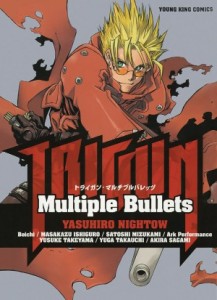By Various Artists, series created by Yasuhiro Nightow. Released in Japan by Shonen Gahosha direct to tankobon. Released in North America by Dark Horse.
I am generally a manga person, though I have a lot of anime that I love. But if you were to ask me which I preferred, the manga or the anime, 90% of the time I would pick the former. Trigun is one of those exceptions, however. I saw the anime first, and was entertained and riveted by its over the top action and comedy slowly wending its way towards inevitable tragedy. It, like many other Shonen Gahosha series (including Hellsing and Excel Saga) was licensed for an anime very early on in its run, so had an ending that had many of the same beats the author wanted but was distinctly different. Unfortunately, Nightow’s action scenes tend to leave me hopelessly confused, as I simply can’t follow what he’s drawing half the time. His storytelling is also very oblique (typical to a Western). As such, I never really got into Trigun Maximum.
But I picked up this anthology anyway, as I was curious to see what other writers would do with Nightow’s vision. Of course, what most people might pick this up for is Nightow himself – it contains the 80-page story he wrote up to go with the release of the Trigun movie. The story, Badlands Rumble, is pretty much an encapsulation of the manga. Meryl and Milly are there but don’t do anything, Vash is really silly and then not so much, Wolfwood gets irritated but clearly is siding with Vash, and there are innocents and villains who are out of Bob’s Big Book of Western Cliches. If you liked Trigun, you’ll get a kick out of it.
Of the remaining stories, there were two that didn’t really work for me. Boichi’s story about a woman giving birth to an atomic bomb – sort of – and plays on Vash’s pledge to avoid killing. It is, however, filled with Boichi’s fanservice (he writes Sun-Ken Rock), something Trigun is usually blissfully free of. And the 4-koma with Meryl and Milly is really, really slight and not all that funny.
But there’s also some excellent storytelling here. The folks who worked on this anthology love to play around in Nightow’s world, rather than just writing character-based stories about Vash. Satoshi Mizukami, who does my pet favorite The Lucifer and Biscuit Hammer, has a story about whether the various warring races (humans, plants, worms) can really come together, but it’s actually cuter than I make it sound. Yusuke Takeyama’s is dark and depressing, with another typical Western cliche: the bit of hope that is then brutally cut down. That said, it’s tense, gripping stuff. And Sagami Akira’s Vash/Meryl story about the impossibility that is Vash’s hair is really shippy in exactly the same way that the Trigun manga never is. (The anime was a bit better at it.)
And easily the gold standard in this collection is the storybook tale that retells Trigun as a fairy tale, written by Ark Performance (better known for their Gundam stuff). The art is fantastic, the style is gorgeous, and the reveal of who’s telling the story is the perfect sweet (and bittersweet) capper. The entire volume is worth getting just for this 16-page story.
I generally prefer character-driven works to world-building stories, and Trigun definitely falls into the latter category. That said, many writers love walking around in someone else’s world, and Nightow’s is probably one of the best to wade into. This anthology had more hits than misses, and is a good epilogue to the Trigun series.

